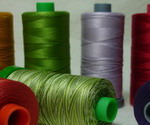Last month I started writing about sewing machine maintenance so this month I thought I would continue the theme by talking about adjusting the thread tension.
It is a timely topic as Lana Wool thread, our Calendar Girl thread for March, is great fun to play with in the sewing machine, but you do need to loosen the top tension for this thicker Ne 12 thread to get best results.

A Pfaff programmed embroidery design, stitched with Lana wool thread.
Apart from the times when you might wish to play with unusual threads, having the ability to adjust the thread tension in both the needle and the bobbin will help keep your sewing machine in good working order.
Good thread tension means that the machine can make a well balanced stitch with the top and bottom thread locking together in the centre of the stitch. If the stitches are forming properly it helps to prevent thread breaks which can cause small pieces of thread to catch in the bobbin race.
People often tell me that they find the thought of adjusting the tension on their machine too scary to consider, but it doesn’t have to be something to fear. I did an internet search and found this great printable reference with drawings of good & poor stitch tension and simple clear instructions about tension adjustments.
There are only two options for changing the thread tension, either the top thread or the bobbin thread, and it is generally easier to start by adjusting the tension on the thread which runs through the eye of the needle. By tightening, or loosening, the tension on the top thread it is possible to allow the locking point between the top & bobbin thread to move back into a balanced position.

On this exposed tension control on my industrial machine you can easily see the disks and spring that control the pressure on the top thread
The tension dial for the top thread has two disks between which the thread travels, and the gap between the disks is controlled by a spring. Usually the only part that is visible on a domestic sewing machine is the dial that controls the spring. As you move the dial, to open (loosen) or close (tighten) the tension on the thread, keep a record of the positions that work for different threads or types of stitches.

On some machines the tension dial is hidden inside the machine case.
Before you start making any changes clean & re-thread your machine and make a stitch sampler & record the current settings. Most machines will have numbers on the dial, but if the dial on your machine is blank use a permanent marker to add your own numbers or simply draw yourself a clock face record.

A clearly marked top tension guide. Rotate the dial to the right to tighten the thread tension or to the left to loosen the tension.
Depending upon your sewing machine, the bobbin either goes directly into the bobbin race in the machine, or it is put into a separate bobbin case before that is inserted into the bobbin race. Most machine handbooks will have some clear photos to show you how to thread & set the bobbin into the machine.

A removable bobbin case, showing the tension spring and screw fitting
In both cases the tension on the thread is controlled by turning a small screw that will open (loosen) or close (tighten) a “spring” .

Some machines are designed to have the bobbin dropped directly into the bobbin race
When adjusting the bobbin tension the secret is to make miniscule turns on the screw as a small adjustment can make a big difference to the ease with which the thread can travel. I have a tiny screw driver in my sewing kit that came out of the repair kit for my spectacles. (These little “handbag” repair kits are usually available from an optometrists)
HINT 1: “Righty Tighty, Left Loosey” is the adjusting meme/mantra that helps me remember which way to turn the top tension dial and bobbin set screw.
HINT 2: If the machine tension is badly out of balance thread the bobbin & needle with two different thread colours, of the same thread type, so that it is easy to identify which thread is pulling tighter than the other.
HINT 3: If your machine has a separate bobbin holder you can always purchase a second holder and keep it permanently adjusted for the slippery or fancy threads.
Now it is time to have some fun machine stitching. Don’t forget to tell us about your latest project.
Filed under: Aurifil Lana wool, Home page, Studio Organisation | Tagged: Bobbin, sewing machine | 1 Comment »







































































